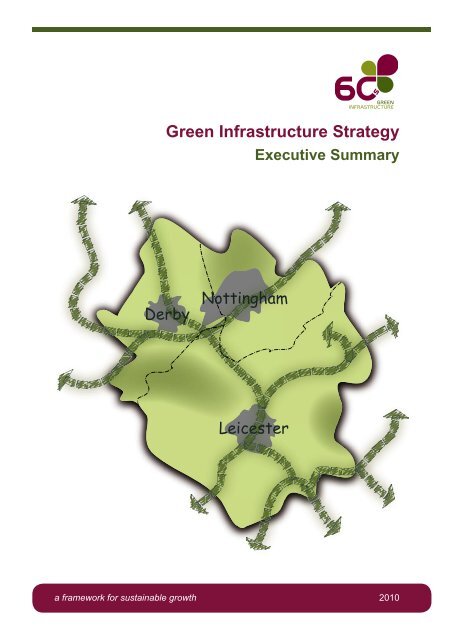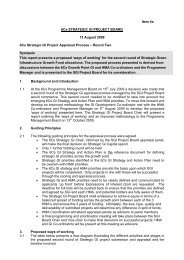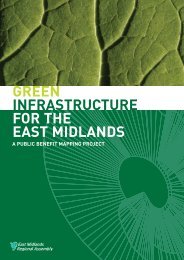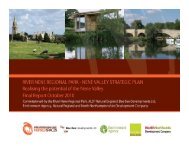6Cs GI Strategy Executive Summary (pdf 3.5Mb) - River Nene ...
6Cs GI Strategy Executive Summary (pdf 3.5Mb) - River Nene ...
6Cs GI Strategy Executive Summary (pdf 3.5Mb) - River Nene ...
Create successful ePaper yourself
Turn your PDF publications into a flip-book with our unique Google optimized e-Paper software.
Green Infrastructure <strong>Strategy</strong><strong>Executive</strong> <strong>Summary</strong>DerbyNottinghamLeicestera framework for sustainable growth2010
BackgroundThe Three Cities (Derby, Leicester and Nottingham), and the Three Counties (Derbyshire,Leicestershire and Nottinghamshire) – called the <strong>6Cs</strong> sub-region - is one of 29 areas with GrowthPoint status proposed nationally under the Sustainable Communities Plan for signifi cant housinggrowth. The East Midlands Regional Plan therefore allocates 177,600 new homes to be built in thearea by 2026.‘Green Infrastructure comprises the networks of multi-functional greenspace which sit within, andcontribute to, the type of high quality natural and built environment required to deliver sustainablecommunities. Delivering, protecting and enhancing these networks require the creation of newassets to link with river corridors, waterways, woodlands, nature reserves, urban greenspace,historic sites and other existing assets.’(East Midland Regional Plan, 2009)The <strong>6Cs</strong> Green Infrastructure <strong>Strategy</strong> provides an overarching strategicframework to 2026 for Green Infrastructure (<strong>GI</strong>) planning, investment anddelivery by stakeholders working across the environmental, economic andsocial sectors. It has been produced to assist with and guide actions on thedelivery of multi-functional <strong>GI</strong> within the sub-region as part of its long termsustainable development. The <strong>Strategy</strong> takes a long term and holistic view of <strong>GI</strong>requirements, and many of its recommendations would still be applicable in theabsence of Growth Point status.The <strong>Strategy</strong> was commissioned in 2008 by the <strong>6Cs</strong> Strategic Green Infrastructure Project Board,a partnership of local authorities and environmental agencies with responsibility for overseeingthe planning and delivery of <strong>GI</strong> across the <strong>6Cs</strong> sub-region. It is based on recommendations ofwork developed in stages over 12 months by Chris Blandford Associates, and has been informedby extensive consultations with over 100 local stakeholders involved in planning, managing anddelivering <strong>GI</strong> and sustainable development across the sub-region.
Baseline EvidenceThe <strong>Strategy</strong> is based on a wide ranging study of existing <strong>GI</strong> assets in the sub-region atboth the sub-regional (Volume 3) and city scales (Volumes 4-6). This data and maps will form avaluable strategic evidence base for more detailed work at individual local authority level.This baseline study should significantly reduce the amount of data requiredto produce local <strong>GI</strong> strategies and may be referenced and used as the basis ofmore local work.
Proposed Vision for <strong>GI</strong>Volume 1 sets out strategic aims and objectivesfor the <strong>6Cs</strong> <strong>GI</strong> <strong>Strategy</strong> and a proposed Visionfor <strong>GI</strong> in the <strong>6Cs</strong> sub-region.The long term Vision for <strong>GI</strong> in the <strong>6Cs</strong> subregionis to maintain, enhance and extenda planned multi-functional <strong>GI</strong> network. This willcomprise existing and new greenspaces, naturaland cultural features and interconnected green linksin and around the three cities of Derby, Leicester andNottingham, connecting with their surrounding townsand villages as part of the sustainable growth of thesub-region. The river valleys of the Trent, Soar andDerwent and their tributaries provide the ‘backbone’ of thenetwork, linking the three cities with each other.A major step-change in the scale, quality andconnectivity of <strong>GI</strong> assets will be required to match the scale of new growth planned inorder to deliver environmental, economic and social benefi ts. This will be achieved through thecommitment of stakeholders involved in planning, delivering and managing <strong>GI</strong> and sustainabledevelopment across the <strong>6Cs</strong> sub-region working in partnership to establish the network as alasting legacy for future generations.The network will provide increased opportunities for communities in and around the threecities to access a variety of greenspaces on their doorsteps and in the wider countryside. It willbe set within, and contribute to, a high quality natural, cultural and built environment that providessubstantial quality of life benefits for residents and visitors, and is a focus for attracting and retainingeconomic investment in the area.The network will be a framework for delivering biodiversity benefi ts on a landscape scale,and as appropriate to the local landscape character, by protecting, connecting and creatinga diverse range of wildlife habitats and providing ecological corridors for species dispersal andmigration.Investment in the network will contribute to our environmental, economic and socialadaptation and mitigation to the challenges of climate change.
The Strategic <strong>GI</strong> Network<strong>GI</strong> planning and delivery operates at a range of scales, and involves ahierarchy of inter-connected networks where strategic investment in <strong>GI</strong>provision is considered to have greatest potential to deliver benefits for the<strong>6Cs</strong> sub-region.Commensurate with the strategic purpose of the <strong>Strategy</strong>, the datasets have allowed sub-regionalstrategic and city-scale indicative <strong>GI</strong> networks linking these key assets to be identifi ed.The purpose of these networks is to provide the conceptual framework or‘bigger picture’ for the delivery of large-scale enhancement projects and toform key elements in local <strong>GI</strong> studies. These include policies in Local DevelopmentDocuments that respond to locally identifi ed needs and identify the scale and location of <strong>GI</strong>required to create linked networks of green space.They are intended to help focus attention or priority on the strategic location of land that needsto be safeguarded, managed or secured in positive ways to create a multifunctionalnetwork of green spaces and assets, for which investment in <strong>GI</strong> can deliverthe greatest range of benefi ts in the context of government policy priorities. It is recognised that theStrategic <strong>GI</strong> Network is intended to be fl exible and responsive to opportunities - such as access tofunding and development opportunities - that may change priorities for investment over time.The spatial framework for the strategic planning and delivery of <strong>GI</strong> within the<strong>6Cs</strong> sub-region is illustrated at three spatial levels:• Sub-Regional <strong>GI</strong> Corridors – to maintain the integrity of the <strong>GI</strong> Network in the long-term,and connect the <strong>6Cs</strong> Network to wider Regional <strong>GI</strong> Corridors.• City-Scale <strong>GI</strong> Corridors – to connect the sub-regional corridors, the urban fringe and theurban cores related to specifi c principal urban areas and sub-regional centres.• Urban Fringe <strong>GI</strong> Enhancement Zones - to deliver <strong>GI</strong> benefits for both existing and newcommunities (Sustainable Urban Extensions) related to specific principal urban areas and subregionalcentres in the local areas where most development is likely to take place.
DerbyNottinghamLeicesterSub-regional <strong>GI</strong> corridorsCity scale <strong>GI</strong> corridorsUrban fringe <strong>GI</strong> enhancement zones
The Delivery FrameworkTo assist in guiding the delivery of the proposed vision and network, Volume 1 of the <strong>Strategy</strong> alsosets out:•••key principles for the short and long term planning and delivery of <strong>GI</strong> within the <strong>6Cs</strong>sub-region.strategic mechanisms and funding sources for delivery of <strong>GI</strong>.a framework for appraising <strong>GI</strong> projects for funding.The Delivery Framework recognises that Growth Fund available to the <strong>6Cs</strong> partnership providesinitial investment towards a step change in the scale and type of <strong>GI</strong> delivery. Long term fundingand support for <strong>GI</strong> delivery will realistically come from a number of sources and different partners,particularly via new development and the voluntary sector and a creative use of potential fundingsources will be needed which refl ects the variety of sustainability benefi ts <strong>GI</strong> can deliver. It alsonotes the critical need to identify, from the outset, ways of sustainably managing <strong>GI</strong>in the long term, and suggests some of the creative ways this can be done.Volume 2 sets out a stand alone Action Plan developed in consultation with partners andstakeholders. It identifi es priorities for action related to promotion and advocacy of the <strong>GI</strong>principles, and existing and proposed strategic initiatives for delivering the Strategic <strong>GI</strong> Network.
Next Steps for <strong>GI</strong> DeliveryTo meet the requirements of the Regional Plan, the <strong>6Cs</strong> <strong>GI</strong> <strong>Strategy</strong> needs to be fully integratedinto the Local Development Frameworks for the sub-region, and supported by policies at a locallevel. This will establish local priorities for <strong>GI</strong> investment and action, and identify <strong>GI</strong> requirementsin relation to the masterplanning and design process for individual development schemes at thesite scale.It is intended that the Strategic Framework and Action Plan are kept under review, andupdated as necessary in the light of changing circumstances and new thinking, to continueproviding a coherent sub-regional framework for <strong>GI</strong> planning and delivery in the <strong>6Cs</strong> sub-region.ContactsThe <strong>Strategy</strong> is available to view and download via the <strong>6Cs</strong> <strong>GI</strong> website hosted by the East MidlandsGreen Infrastructure Network.www.emgin.co.uk/<strong>6Cs</strong>For further information, please contact the <strong>6Cs</strong> <strong>GI</strong> Development Coordinator:sharon.jefferies@leics.gov.ukgreg.phillips@leics.gov.uk
www.emgin.co.uk/<strong>6Cs</strong>
















